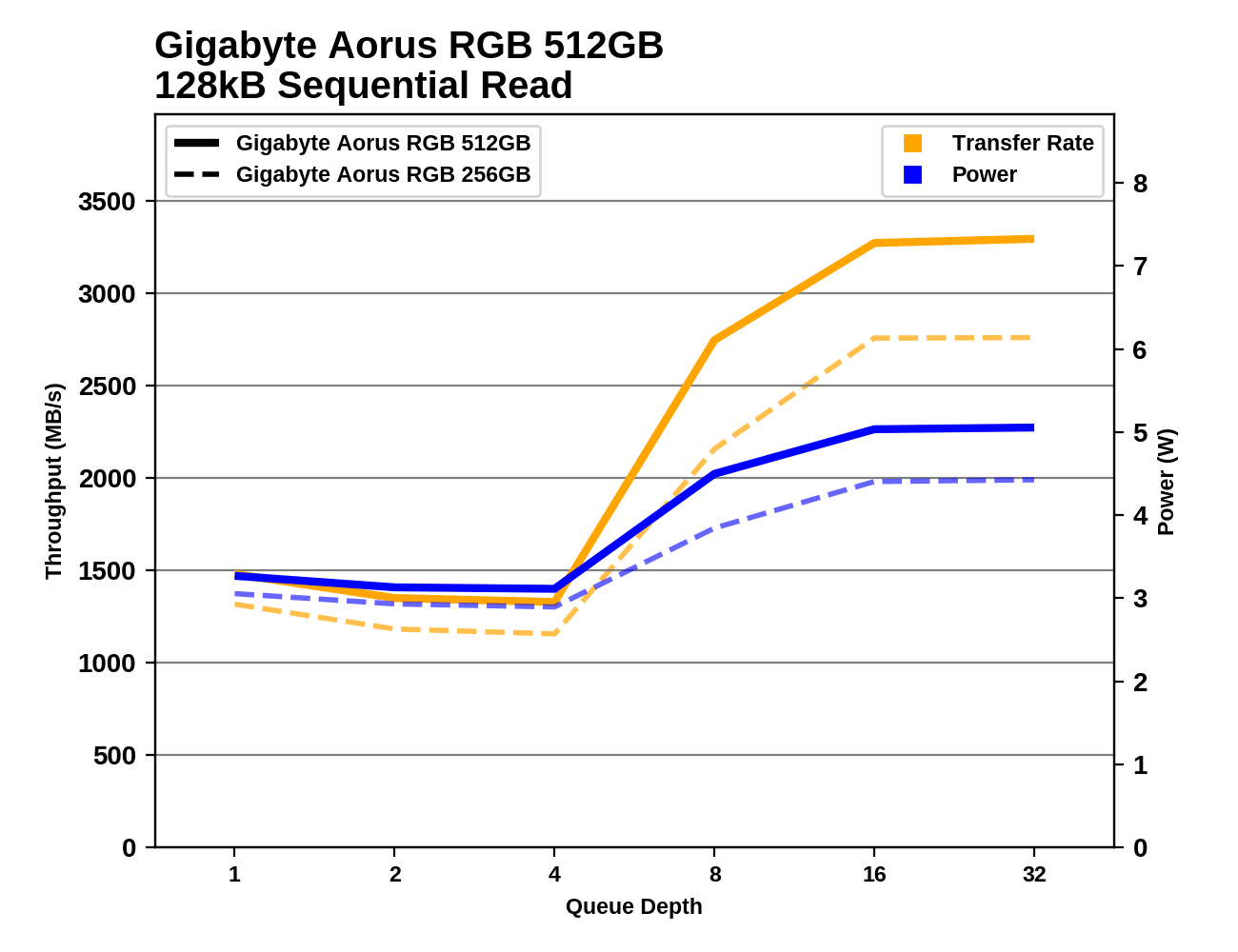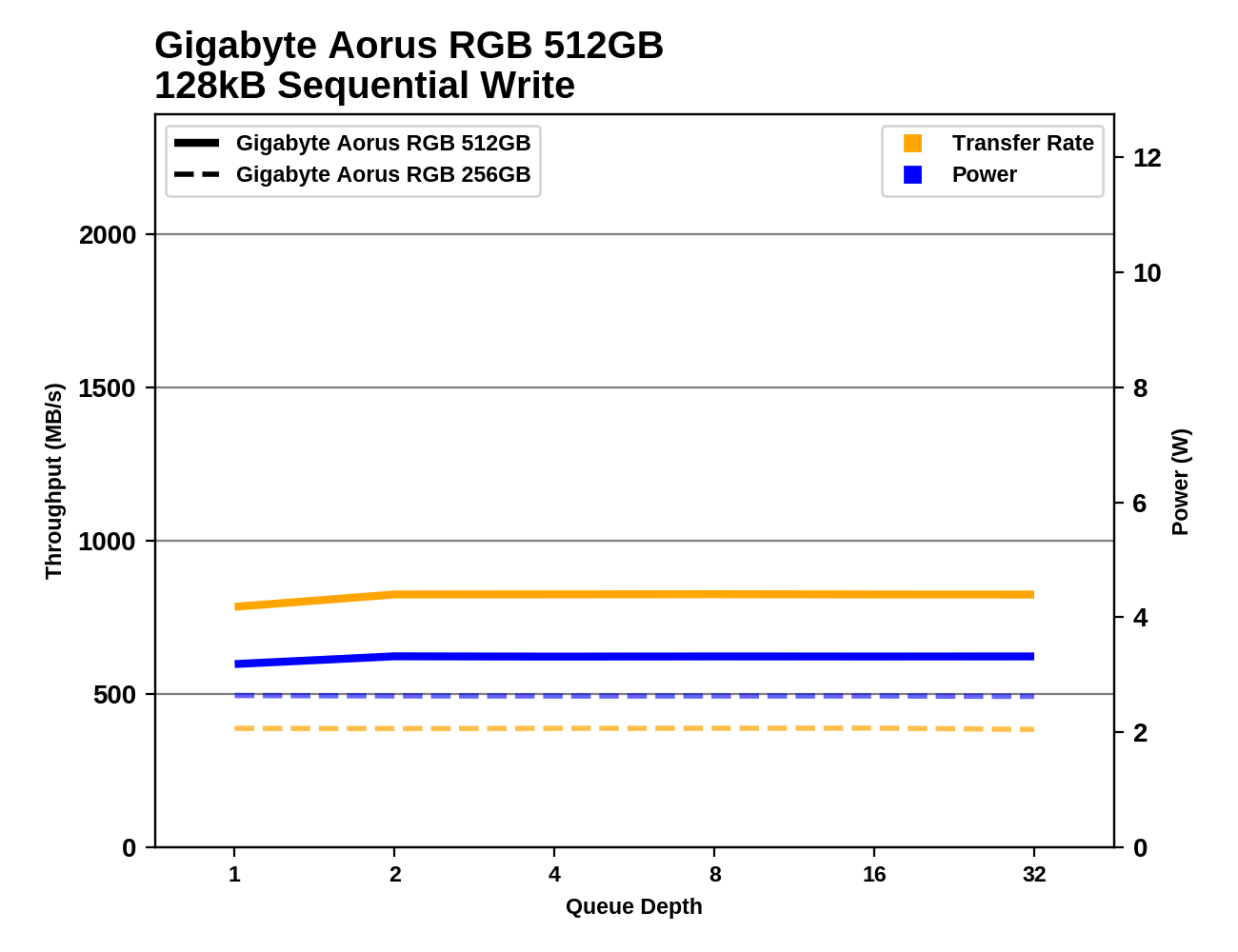The GIGABYTE Aorus RGB M.2 SSD Review: Nothing Is Too Small For RGB LEDs
by Billy Tallis on April 10, 2019 8:00 AM ESTSequential Read Performance
Our first test of sequential read performance uses short bursts of 128MB, issued as 128kB operations with no queuing. The test averages performance across eight bursts for a total of 1GB of data transferred from a drive containing 16GB of data. Between each burst the drive is given enough idle time to keep the overall duty cycle at 20%.

The QD1 burst sequential read performance of the GIGABYTE Aorus RGB SSDs is quite clearly in the high-end NVMe tier, but they are the slowest drives in this market segment with performance in the 1.8-1.9GB/s range compared to 2.4GB/s for the ADATA SX8200.
Our test of sustained sequential reads uses queue depths from 1 to 32, with the performance and power scores computed as the average of QD1, QD2 and QD4. Each queue depth is tested for up to one minute or 32GB transferred, from a drive containing 64GB of data. This test is run twice: once with the drive prepared by sequentially writing the test data, and again after the random write test has mixed things up, causing fragmentation inside the SSD that isn't visible to the OS. These two scores represent the two extremes of how the drive would perform under real-world usage, where wear leveling and modifications to some existing data will create some internal fragmentation that degrades performance, but usually not to the extent shown here.

On the longer sequential read test that goes a bit beyond QD1, the Aorus and other Phison E12-based SSDs fall well behind other recent high-end NVMe SSDs. However, the E12 drives do provide competitive performance when reading data that was not written sequentially.
 |
|||||||||
| Power Efficiency in MB/s/W | Average Power in W | ||||||||
The Aorus SSDs and other Phison E12 drives also lag behind other top NVMe drives on the power efficiency scores for the sequential read test, but it's not a large gap as it was for raw performance. In absolute terms, the Aorus SSDs only draw slightly more power than SATA SSDs or the entry-level NVMe drives based on the Phison E8.
 |
|||||||||
The Aorus SSDs continue the pattern of Phison E12 drives requiring high queue depths before sequential read performance starts to improve beyond the QD1 performance; this is also evident to a lesser extent with Phison E8 drives, but most of the competition is at or close to its full speed by QD2.
 |
|||||||||
| 512 GB | 256 GB | ||||||||
At sufficiently high queue depths, the 512GB Aorus SSD provides reasonable performance and power efficiency for a high-end NVMe SSD, falling in the middle of the cluster of results that surpass 3GB/s. The smaller 256GB model doesn't quite get there in terms of performance, but when it does saturate it at least offers decent power efficiency for the speed.
Sequential Write Performance
Our test of sequential write burst performance is structured identically to the sequential read burst performance test save for the direction of the data transfer. Each burst writes 128MB as 128kB operations issued at QD1, for a total of 1GB of data written to a drive containing 16GB of data.

The 256GB and 512GB Aorus SSDs offer far less performance on the burst sequential write test than a 1TB drive using the same controller and flash, and the Aorus drives are also underperforming all the competition of comparable capacity. The 256GB Aorus even manages to be slower than the 256GB MyDigitalSSD SBX, based on the lower-end Phison E8 controller.
Our test of sustained sequential writes is structured identically to our sustained sequential read test, save for the direction of the data transfers. Queue depths range from 1 to 32 and each queue depth is tested for up to one minute or 32GB, followed by up to one minute of idle time for the drive to cool off and perform garbage collection. The test is confined to a 64GB span of the drive.

On the longer sequential write test that includes some higher queue depths, the Aorus SSDs are clearly faster than the entry-level NVMe drives but are not competitive with the top high-end drives. The ADATA SX8200 based on the Silicon Motion SM2262 is able to compete against Phison E12 drives twice its size on this test, and the Samsung drives also have a substantial lead over the Aorus SSDs.
 |
|||||||||
| Power Efficiency in MB/s/W | Average Power in W | ||||||||
The 512GB Aorus SSD has decent but not class-leading power efficiency on the sequential write test, but the 256GB model scores much lower, thanks to having less than half the raw performance. In spite of the RGB LEDs, the Aorus drives are still some of the lowest-power drives in the high-end NVMe market segment, but in cases like this test, that's because they're having a hard time keeping up with the competition.
 |
|||||||||
The performance of the Aorus SSDs during the sequential write test is quite flat across the range of queue depths. Each phase of the test writes more than enough data to fill the SLC cache, while the 1TB Silicon Power P34A80 with the same Phison E12 controller shows wild performance oscillations because its SLC cache size and best-case write speed are significantly larger.
 |
|||||||||
| 512 GB | 256 GB | ||||||||
The smaller 256GB Aorus SSD's performance and power consumption on the sequential write test are stuck down in SATA SSD territory. The larger 512GB model is fast enough to significantly outpace SATA drives, but among the broader field of NVMe competition it is unimpressive.










23 Comments
View All Comments
Death666Angel - Thursday, April 11, 2019 - link
It's an ice skating eagle head, obviously.ShieTar - Thursday, April 18, 2019 - link
Staple remover. The logo emphasises the dual focus of Gigabyte on workplace functionality and animal decapitation.Thud2 - Wednesday, April 10, 2019 - link
OK, I think I'm seeing a "G"?letmepicyou - Wednesday, April 10, 2019 - link
I wonder if Gigabyte has any plans to offer the heatsink alone. I have the Z390 Aorus Pro Wifi, but have no plans to replace my 500gb Samsung 950 Pro M.2 anytime soon. Would be nice to see this released as a stand-alone accessory.timecop1818 - Wednesday, April 10, 2019 - link
Even if they did, what good would it do? The 2 corner mounting holes are not standard for M.2.You'd have to ziptie or glue or somehow else attach the HS to your SSD.
letmepicyou - Friday, April 12, 2019 - link
Well obviously if they released it as a stand-alone component they would have to make it compatible with standard M.2 drives...I don't know how that doesn't go without saying but I guess I had to say it...Azurael - Thursday, April 11, 2019 - link
My motherboard places the m.2 slot behind the GPU (just so it can bask in the heat of my Vega64), so this would be pointless, even if I cared about lights. The only reason I mention it is that it's a Gigabyte Aorus motherboard... D'oh!shabby - Thursday, April 11, 2019 - link
You guys like shaming the 7200rpm spinner?cpugod - Thursday, April 11, 2019 - link
I think the term for this sort of LED bling should be referred to as "Incel lighting"WelshBloke - Sunday, April 14, 2019 - link
It is getting ridiculous. When I was buying RAM all I could get was stuff with ludicrous fairy lights on.I mean what functioning adult wants the inside of his PC to look like a pixies acid disco!